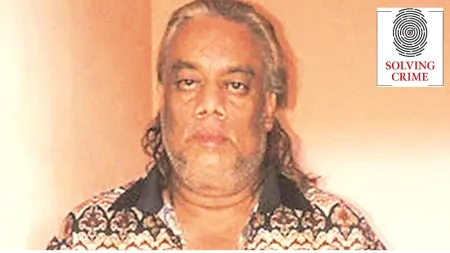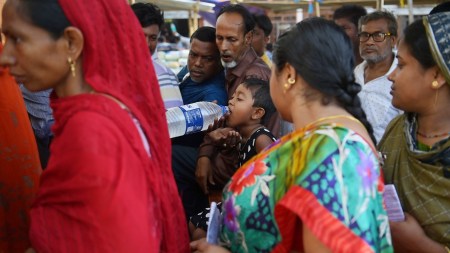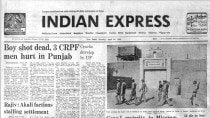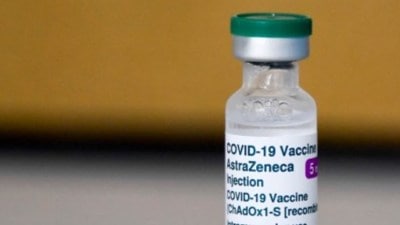- India
- International
How data can empower MPs to serve people better
There is very little data on welfare indicators at parliamentary constituency level. Digital tools can address this deficit
 A new interactive PC data tracker developed by the Geographic Insights Lab at Harvard University has for the first time provided data on crucial population, health, and well-being estimates for each of the 543 PCs, and including a factsheet for each PC. (Illustration: C R Sasikumar)
A new interactive PC data tracker developed by the Geographic Insights Lab at Harvard University has for the first time provided data on crucial population, health, and well-being estimates for each of the 543 PCs, and including a factsheet for each PC. (Illustration: C R Sasikumar) India’s parliamentary constituencies (PCs) serve a dual role as geographical and administrative policy units headed by democratically elected Members of Parliament (MPs), who are responsible for fulfilling the needs and aspirations of their constituents through impactful policy. For MPs to effectively engage with their constituents, it is imperative to understand and prioritise the issues most impacting their communities. Unfortunately, at present, timely and readily available data on critical issues related to population health and socioeconomic well-being is lacking at the PC level.
With the launch of the National Data Sharing and Accessibility Policy (NDAP) in 2012, the Government of India (GOI) made a concerted effort to make a variety of data related to population health and well-being from current GOI schemes more accessible. In recent years, district-level data — whether from GOI administrative data or independent surveys such as the National Family Health Surveys (NFHS) — has emerged as a key input for policy deliberations.
Increasing the availability of district-level data, or data that allows aggregation at the district level does not help the cause of the PC having the same data. This is because the 750-plus district boundaries of India do not correspond or are aligned in a straightforward manner with the 543 PCs of India. The districts and PC boundaries crisscross: A district can have parts of or an entirety of multiple PCs intersecting it. Similarly, a PC can have parts of a district or a multiplicity of entire districts intersecting it.
Even though there is substantial overlap in the names of districts and PCs (391 of the 543 PCs share the exact name of a district), having the same name doesn’t mean they are capturing the same population with regard to its size and composition.
Consider the PC and district of Kannauj (Uttar Pradesh) with the same name but serving completely differing populations. The entirety of the Kannauj district constitutes only a part of the Kannauj PC. The Kannauj PC includes populations from the neighbouring districts of Auraiya and Kanpur Dehat.

With districts having the administrative responsibilities for customising and implementing GOI programmes, the MP from Kannauj would need to interact with district collectors (DC) from three districts to implement their promises towards their constituents. Crucially, the MP will be given data by each of the three district administrations but will never get an accurate picture of the constituents he or she is serving.
The example of Kannauj is simply an illustration of the lack of congruence in district and PC populations that is far more extensive. Approximately, only 28 PCs have the same geometry as the districts. In the remaining PCs, there are various ways in which districts intersect PCs. It is very likely that when there is a request by an MP to know, for instance, the level of child undernutrition in their respective PC, the statistics from the district are likely to be shared. This could be misleading. For instance, in the district of Kannauj, 56.8 per cent children aged 12-23 months were fully vaccinated based on information ascertained from the vaccine card. However, in the population that constitutes the Kannauj PC, this figure is 69.7 per cent. Such mischaracterisations are consequential. For instance, in the Hamirpur PC in Himachal Pradesh which intersects five districts (Hamirpur, Kangra, Una, Mandi, and Bilaspur), the prevalence of mothers who had at least four antenatal care visits is 75.5 per cent, while it is 59.4 per cent in the district of Hamirpur.
With data-based monitoring and governance of populations becoming central to identifying priorities, it is critical that MPs are empowered with appropriate data that relates to the populations they have been elected to serve and are able to effectively liaise with multiple district administrations in a manner that allows them to function effectively, efficiently, and independently without having to solely rely on the district administration which is not in a position to provide accurate data on the PC.
Recognising this need for better synergy between district administration and elected representatives, the Ministry of Rural Development issued an order in 2016 to all states and Union Territories to constitute a District Coordination and Monitoring Committee (DDMC), chaired by district MPs and charged with making implementation and monitoring of central schemes more efficient. However, to our knowledge, the data still pertains to districts and not PCs.
Recently, in April 2022, Andhra Pradesh, which was due for reconstituting (increasing) the 13 districts since its separation from Telangana in 2014 decided to use the number and geometry of 25 of its 26 PCs to also create districts. Thus, in Andhra Pradesh going forward, except for Araku PC, its districts and PCs are the same. Indeed, this also suggests in the short run, none of the district data — from the NFHS for instance — is applicable to the districts or PCs of Andhra Pradesh.
A new interactive PC data tracker developed by the Geographic Insights Lab at Harvard University has for the first time provided data on crucial population, health, and well-being estimates for each of the 543 PCs, and including a factsheet for each PC. The data underlying the PC dashboard comes from the NFHS-4 (2015-2016) and NFHS-5 (2019-2021). The methodology powering the PC tracker provides a solution to the existing PC data gap. Using GPS coordinates, the researchers mapped existing NFHS survey clusters onto PC boundary maps, from which indicator prevalence estimates for each PC were estimated.
While this has enabled a reliable PC-level resource for the current data context, a more durable solution would entail that all datasets be consistently geo-tagged for PC (as is currently done routinely for district and state), as a new uniform data standard for all microdata (or data that is disaggregated below district levels such as sub-districts or blocks or villages) reporting in India. Such a solution is compatible with the current policy intent to steadily move towards digitisation of all government data through the 2022 Draft National Data Governance Framework Policy, which calls for the creation of standards for metadata and datasets across ministries. Although still nascent, the announcement of a National Data Governance Policy during the 2023 budget session is a step in the right direction for good governance.
Timely and accessible data at the PC-level can transform the work of MPs by bringing to light the most critical issues and at-risk populations in need of targeted interventions. It can also empower MPs to raise policy questions at multiple levels of governments, from the floor of Parliament to their frequent interactions with the district administrations. Further, it facilitates the MPs to independently initiate and sustain meaningful dialogue with civil society NGOs and other stakeholders to collaboratively address the issues most important to their constituents.
In recent years, India’s elected officials have been engaged more extensively in articulating and shaping the policy agenda. Among consistently well-functioning open democratic countries, there is no historical precedence to governing the process of fulfilling the aspirations of more than a billion people ranging from clean water supply to education to housing to employment to health care and so on. In a democratic set-up, the PCs offer a natural unit for policy deliberation and governance. Bringing timely and frequent data on issues that matter for population health and well-being to PCs can bring much symmetry and synergy between districts (that exist to administer the vision of our elected officials) and the PCs.
The writer is a Professor of Population Health and Geography at Harvard University. He is the Principal Investigator of the India Policy Insights initiative at the Geographic Insights Lab at Harvard
EXPRESS OPINION
More Explained
Apr 30: Latest News
- 01
- 02
- 03
- 04
- 05









































